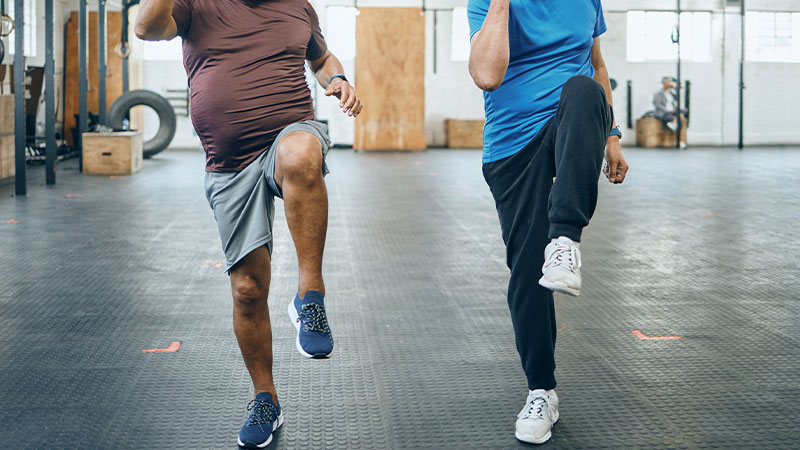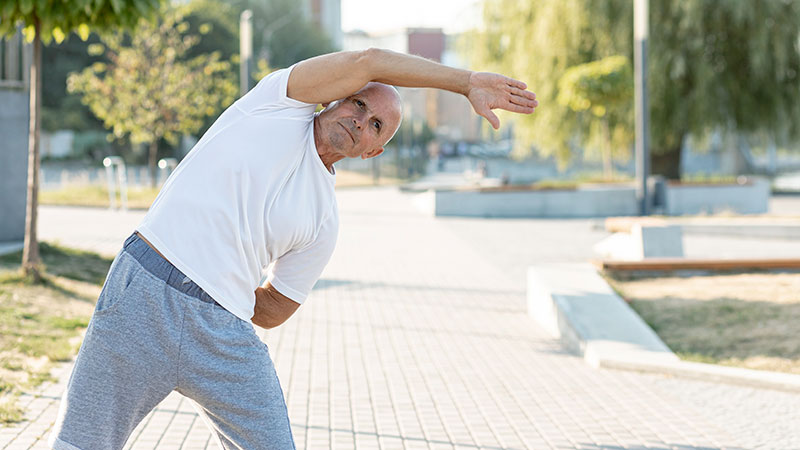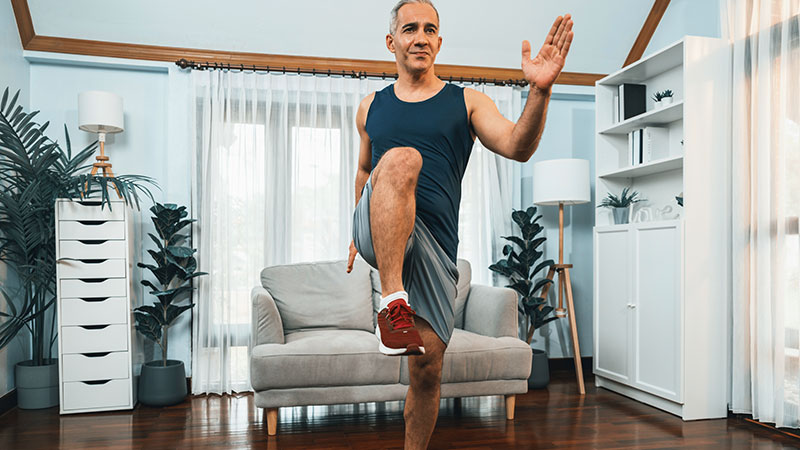Standing Abs workout refers to a series of exercises targeting the core muscles while standing upright. Tailored for seniors over 50, this workout offers numerous benefits essential for maintaining health and vitality.
Unlike traditional floor exercises, standing abs workouts are low-impact. They greatly improve balance, stability, and posture, essential aspects of healthy ageing.
If you strengthen the core muscles it also enhances overall functional fitness. Thus they help everyday movements easier and reduce the risk of falls and injuries.
Additionally, standing abs exercises can be modified to suit various fitness levels and mobility restrictions. These exercises ensure a safe and effective workout routine for seniors.
Join us as we look into the world of standing abs workouts. Here we will uncover the secrets of maintaining a strong and resilient core as we age. So, keep reading to learn everything you need to know about this topic.
What Is Standing Abs Workout?
The standing abs workout is a form of exercise specifically designed to target the abdominal muscles while standing upright, rather than lying down on the floor.
This workout is particularly beneficial for seniors due to its low-impact nature and focus on core strength. It can surely help improve balance, stability, and posture, all critical aspects of healthy ageing.
By engaging the core muscles in a standing position, seniors can enhance their functional fitness. It can also help them make everyday movements easier and reduce the risk of falls and injuries.
Additionally, standing abs exercises can be modified to accommodate various fitness levels and mobility restrictions.
- Improved balance and stability: Standing abs exercises engage the core muscles, helping seniors maintain better balance and stability. Thus they help reduce the risk of falls.
- Enhanced posture: Strengthening the abdominal muscles can promote better posture. Also, it is essential for overall spinal health and preventing back pain.
- Functional fitness: By targeting the core muscles in a standing position, seniors can improve their ability to perform daily activities. These might include walking, bending, and reaching, with greater ease and efficiency.
- Reduced risk of injury: Building core strength through standing abs workouts can help seniors maintain better body mechanics. It also reduces the risk of strain or injury during everyday movements.
- Adaptability: Standing abs exercises can be easily modified to accommodate seniors. It is great for seniors to have a personalised and safe workout routine.
Preparation for Standing Abs Workout
Preparation for a standing abs workout involves several key steps to ensure safety, effectiveness, and maximum benefit for seniors. Before beginning any exercise program, it’s essential for seniors to consult with their healthcare provider.
Moreover, it is especially required if they have any underlying health conditions or concerns. Once clearance is obtained, seniors can follow these steps to prepare for a standing abs workout:
Warm-Up
You must start with a gentle warm-up to increase blood flow to the muscles and prepare the body for exercise. This aspect can include activities such as marching in place, arm circles, or gentle stretching movements for the upper and lower body.
Proper Footwear

You should always wear supportive and comfortable footwear with good traction to provide stability and reduce the risk of slipping or falling during the workout.
Always remember to avoid shoes with high heels or worn-out soles, as they can compromise balance and safety.
Clear Space
Choose a well-lit and clutter-free area with enough space to perform standing abs exercises comfortably. You should ensure that there are no obstacles or hazards nearby that could cause tripping or injury.
Posture Awareness
You must focus on maintaining good posture throughout the workout by standing tall with shoulders relaxed, spine neutral, and core engaged.
If you maintain proper alignment, it will help you to maximise the effectiveness of the exercises. This condition will also reduce the risk of strain or injury.
Breathing Technique

Pay attention to your breathing and practise diaphragmatic breathing. It is about inhaling deeply through the nose and exhaling fully through the mouth.
If you engage the diaphragm it will help you to stabilise the core and enhance the effectiveness of the exercises.
Start Slowly
Begin with exercises that are appropriate for your fitness level and gradually progress as strength and endurance improve.
You should start with a few repetitions of each exercise and gradually increase the intensity and duration over time.
Modify as Needed
Always be prepared to modify exercises to accommodate any physical limitations or discomfort.
You can use support such as a sturdy chair or wall for balance if needed. Remember, you must always choose variations of exercises that feel challenging yet manageable.
Listen to Your Body
It is better to pay attention to how your body feels during the workout and stop if you experience any pain, dizziness, or shortness of breath.
It’s very important to honor your body’s signals. You should avoid pushing beyond your limits.
By following these preparation steps, seniors can safely engage in a standing abs workout. These workouts will help them improve their core strength, balance, and overall functional fitness.
10 Best Standing Abs Workout for Over 50
For individuals over 50, standing abs workouts offer a safe and effective way to strengthen the core muscles while improving balance, stability, and posture.
Let’s explore the 10 best standing abs exercises specifically tailored for seniors to promote functional fitness and support healthy ageing:
1. Standing knee lift

Standing knee lifts target the lower abdominal muscles, hip flexors, and improve balance and stability. This exercise helps strengthen the core, which is essential for everyday activities and maintaining proper posture.
- Try to stand with feet hip-width apart, arms by your sides.
- Lift one knee towards your chest, keeping the abs engaged.
- You should lower the leg back down and repeat on the other side.
- Perform 10-15 repetitions on each leg, gradually increasing as strength improves.
2. Standing Side Bends

Standing side bends primarily target the obliques, which are the muscles on the sides of the waist. This exercise helps to tone and strengthen the waistline, improving overall core stability and posture.
- Stand with feet shoulder-width apart, arms relaxed by your sides.
- You should place one hand on your hip and extend the other arm overhead.
- Then slowly bend towards the side, keeping the core engaged and avoiding leaning forward or backward.
- Return to the starting position and repeat on the other side.
- You must perform 10-12 repetitions on each side, focusing on controlled movements.
3. Standing Twists with Resistance Band

Standing twists with a resistance band engage the entire core, including the obliques and transverse abdominis. The resistance band adds extra challenge. It can help you to improve your strength and flexibility in the torso muscles.
- You must stand with feet hip-width apart, holding a resistance band with both hands at chest level.
- Engage the core and twist the torso to one side, keeping the hips facing forward.
- Then return to the centre and repeat the twist on the other side.
- You should perform around 12-15 repetitions on each side, maintaining tension in the resistance band throughout the movement.
4. Standing Leg Raises

Standing leg raises target the lower abdominal muscles, hip flexors, and improve balance and stability. This exercise also helps to strengthen the muscles around the hip joint. It will reduce the risk of injury and improve your overall mobility in old age.
- Stand with feet hip-width apart, holding onto a stable surface for support if needed.
- You should lift one leg straight out in front of you, keeping the core engaged and avoiding leaning backward.
- After that lower the leg back down with control and repeat on the other side.
- You can perform around 10-12 repetitions on each leg, focusing on controlled movements and maintaining balance.
5. Woodchoppers

Woodchoppers are dynamic exercises that target the obliques, rectus abdominis, and shoulder muscles. This exercise mimics the motion of chopping wood.
It engages your multiple muscle groups and promotes your functional strength for daily activities.
- You must stand with feet wider than hip-width apart, holding a weight or medicine ball with both hands.
- Then start with the weight at one side of the body, then rotate the torso and lift the weight diagonally across the body, ending above the opposite shoulder.
- You should keep your core engaged and maintain a slight bend in the knees throughout the movement.
- Return to the starting position and repeat on the other side.
- Remember to perform over 10-12 repetitions on each side, focusing on smooth and controlled movements.
6. Standing Torso Rotations

Standing torso rotations target the obliques, improving rotational strength and flexibility in the spine. This effective exercise enhances core stability, aiding in better posture and reducing the risk of back pain.
- You should stand with feet hip-width apart, knees slightly bent, and hands clasped in front of the chest.
- Engage the core and rotate the torso to one side, keeping the hips facing forward.
- Then return to the centre and repeat the rotation on the other side.
- Try to perform 12-15 repetitions on each side, focusing on controlled movements and maintaining stability.
7. Standing Oblique Crunches

Standing oblique crunches effectively target the oblique muscles, promoting a strong and toned waistline. This exercise improves your core strength and stability. They can increase your overall functional fitness and support your body’s proper posture.
- Stand with feet hip-width apart, hands behind the head or crossed over the chest.
- Then lift one knee towards the opposite elbow while simultaneously crunching the torso sideways.
- You should squeeze the obliques at the top of the movement, then return to the starting position.
- Try to repeat on the other side, alternating sides for 10-12 repetitions per side.
8. Standing Bicycle Crunches

Standing bicycle crunches engage the rectus abdominis, obliques, and hip flexors, providing a comprehensive core workout. This exercise can improve your abdominal strength and coordination. Thus it will contribute to your body’s better balance and stability.
- Stand with feet hip-width apart, hands behind the head or crossed over the chest.
- You should lift one knee towards the chest while simultaneously rotating the torso to bring the opposite elbow towards the knee.
- Then try to extend the opposite leg out straight, mimicking a bicycling motion.
- You should continue alternating sides in a fluid motion for 12-15 repetitions per side.
9. Standing Toe Touches

Standing toe touches primarily target the lower abdominal muscles and hamstrings, promoting flexibility and core strength. This exercise also improves balance and coordination, enhancing overall functional fitness.
- You must stand with feet shoulder-width apart, arms extended overhead.
- Engage the core and hinge at the hips, reaching the hands towards the toes.
- Then you should keep the back straight and chest lifted throughout the movement.
- Return to the starting position and repeat for 10-12 repetitions, focusing on controlled movements and maintaining balance.
10. Standing Mountain Climbers

Standing mountain climbers provide a dynamic cardiovascular workout while engaging the core muscles.
This exercise improves your body’s agility, coordination, and endurance. It can make an effective full-body workout for you as a senior.
- You must stand with feet hip-width apart, arms by your sides.
- Lift one knee towards the chest while simultaneously raising the opposite arm overhead.
- Then quickly switch legs and arms in a running motion, keeping the core engaged.
- You should continue alternating legs at a moderate pace for 30-60 seconds, focusing on maintaining proper form and breathing rhythm.
By regularly performing these 10 standing abs workouts, seniors can improve their balance, stability, and posture. They also promote the overall health and vitality of the older people.
Remember, you should start slowly and listen to your body. Then you can gradually increase intensity as strength and endurance improve. With dedication and consistency, these exercises can contribute to a strong and active lifestyle for years to come.
Making A Routine for Standing Abs Workout for Over 50
A well-rounded standing abs workout routine for individuals over 50 includes a variety of exercises. These workouts target different muscle groups within the core. They also consider factors like balance, stability, and overall fitness level. Here’s a sample routine for the seniors:
Warm-Up (5-10 minutes)
- March in place or walk around the room to increase heart rate and blood flow.
- Try to perform gentle arm circles, side bends, and torso rotations to loosen up the upper body.
- Then complete a few sets of standing knee lifts and leg swings to warm up the lower body.
Main Workout (15-20 minutes)
- Standing Knee Lifts: 3 sets of 12 reps on each leg.
- Standing Side Bends: 3 sets of 12 reps on each side.
- Standing Twists with Resistance Band: 3 sets of 15 reps on each side.
- Standing Leg Raises: 3 sets of 10 reps on each leg.
- Woodchoppers: 3 sets of 12 reps on each side.
- Standing Oblique Crunches: 3 sets of 12 reps on each side.
- Standing Toe Touches: 3 sets of 12 reps.
- Standing Mountain Climbers: 3 sets of 30-45 seconds (perform as many reps as possible in the given time).
Cool Down (5-10 minutes)
Take deep breaths and perform gentle stretches for the entire body. You should focus on the core, hamstrings, and hip flexors. Then you can end with some relaxation techniques like deep breathing or meditation to promote recovery and reduce stress.
By following this routine consistently, Your or other individuals over 50 can strengthen their core muscles.
These workouts can help improve balance and stability of the body. They are great for overall functional fitness for a healthier and more active lifestyle.
Wrapping Up
Incorporating a standing abs workout into the fitness routine of individuals over 50 offers a multitude of benefits that promote overall health and well-being.
By engaging in these exercises, seniors can strengthen their core muscles, improve balance, stability, and posture, and enhance overall functional fitness essential for maintaining independence and vitality as they age.
However, it’s crucial to prioritise safety when embarking on any exercise regimen. Seniors should always consult with a healthcare provider before starting a new workout program, especially if they have any underlying health concerns or medical conditions.
Additionally, it’s essential to listen to your body, start slowly, and gradually increase intensity and duration over time.
By taking these precautions and staying mindful of individual limitations, seniors can enjoy the many benefits of a standing abs workout while minimising the risk of injury.
I am a fitness instructor and I have been in the industry for 9 years. I have a passion for health and fitness.
I am a fitness instructor with over 9 years of experience in the industry. My passion is health and fitness and I would love to share my knowledge with you!